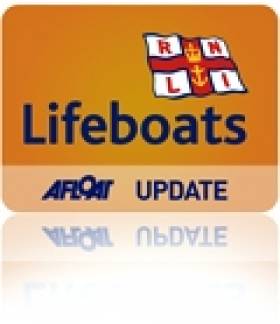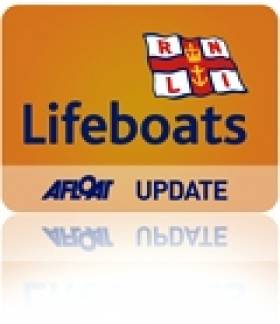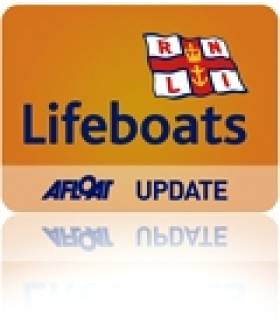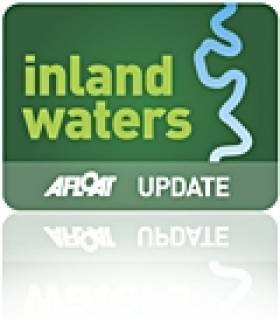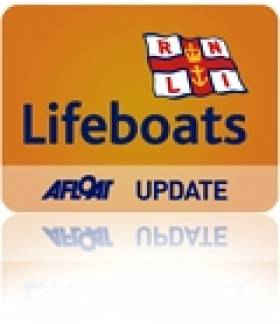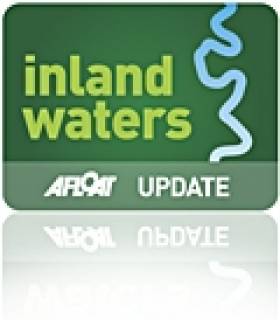Displaying items by tag: Lough Derg
#seaeagle – It is now possible to observe one of the first White Tailed Sea Eagles born in Ireland in over a century courtesy of a new marine wildlife viewing and Iinformation point that has been officially opened on the shores of Lough Derg in County Clare.
Located at Mountshannon Pier and operated by Mountshannon Community Council, the Golden Eagle Trust and Clare County Council, the new Viewing Point features telescopes and information and displays about the White Tailed Sea Eagles. The facility will remain open until the end of September.
Norway's Ambassador to Ireland, His Excellency Roald Næss joined Mayor of Clare Cllr. John Crowe in Mountshannon today in recognition of his country's close links with the Golden Eagle Trust's programme to reintroduce the bird to Ireland.
The Mountshannon breeding pair, a six-year-old male and five-year-old female, were collected as chicks on the island of Frøya off the west coast of Norway by the Golden Eagle Trust. The birds were released in Killarney National Park before relocating to Lough Derg in 2011. The pair, named Saoirse and Caimin, created history in 2013 when they reared the first chicks to fly from a nest in Ireland in 110 years. The pair successfully hatched another chick in late April of this year.
Mayor of Clare Cllr. John Crowe welcomed the introduction of the Viewing Point which he said provides the general public with "a unique opportunity to view the birds at close quarters without disturbing them".
He added: "The breeding success of the Mountshannon pair is in no small part down to the wonderful work of the Golden Eagle Trust, Clare County Council and Mountshannon Community Council, as well as the goodwill and support shown by the local community. This Viewing & Information Point will help to further safeguard these impressive birds and their nesting activities, as well as to promote their ecology and conservation."
Norwegian Ambassador to Ireland, His Excellency Roald Næss described the increase in the number of nesting pairs of White Tailed Sea Eagles in Ireland as "encouraging" and expressed his delight that Norway has played a central role in the reintroduction programme.
He continued: "Norway is home to one of the largest White Tailed Sea Eagle populations in the world and has been instrumental in helping organisations such as the Golden Eagle Trust to reintroduce the species to countries where the bird once flourished but is no longer found. Being able to view this breeding pair thrive here in County Clare is a tribute to everyone concerned and I hope the people who visit this Viewing Point truly value what is happening here."
Welcoming the official opening of the Viewing & Information Point, Dr. Allan Mee, White Tailed Sea Eagle project manager, commented: "We are very conscious of the risk of disturbing the birds especially during nesting periods, so we warmly welcome this structure which is purpose built and designed specifically for the purposes as a Bird Viewing and Information Point. It will help put Mountshannon on the map as the destination to come and enjoy perhaps Ireland's largest and most spectacular breeding bird. To have a nesting pair of eagles here on our doorstep is a unique and one that the local community in Mountshannon will I'm sure help nurture into the future".
The Viewing Point will be maintained by Mountshannon Community Council, whose Chair John Harvey said: "Since the White Tailed Sea Eagles first arrived here three years ago, members of the local community have given tremendous support to the Golden Eagle Trust to ensure the birds were given every possible opportunity to thrive. The Community Council looks forward to welcoming people to the village and the Viewing Point, which we regard as a wonderful addition to the local tourism infrastructure."
Lough Derg RNLI Lifeboat Celebrates Tenth Birthday
#rnli – On May 25, 2014, the Lough Derg RNLI Lifeboat Station celebrated its tenth birthday. In those ten years, the lifeboat has launched 236 times, 60 of those at night. Volunteer crews have rescued 322 people and saved the lives of three people ( the distinction for lives saved versus people rescued, is that for the former, had the lifeboat and her crew not been present to assist, those people would have died).
We are delighted for Ger Egan, recently promoted to Helm at Lough Derg RNLI. Lough Derg RNLI volunteers are dedicated and committed, and are always delighted to welcome new recruits. There is a huge diversity of backgrounds and interests amongst the volunteers, many who have fished and sailed on the lake all their lives, and others for whom the lifeboat is their first experience with water and the lake. No boating experience is required to join the crew, training to the highest standard is provided at Station and at the Lifeboat College at Poole, should you decide to become a volunteer. Come to the Station any Thursday night at 7.30pm or contact the lifeboat for more details by dialling (087) 251 4517
For many years the RNLI and the lifesaving work of its volunteers, have enjoyed the strong support of the people of Nenagh through the tireless efforts of campaigners in the RNLI's expanding fund raising committee, chaired locally by Niamh McCutcheon. The RNLI is a charity that saves lives, it does not receive Governent grants and relies entirely on the contributions and legacies from the public to continue its vital operations.
Lough Derg RNLI Lifeboat Station is one of forty four RNLI Stations operating in Ireland. A local application to station an RNLI lifeboat on Lough Derg, led by Charles Stanley Smith and Teddy Knight, became reality, when, on 25 May 2004, the Lough Derg RNLI Lifeboat officially began service. In the preceding year and a half, volunteer crews and members for the Operations Committee were recruited and underwent intensive training on the water and in the classroom, with RNLI Divisional Trainer Assessor Helena Duggan - our Trainer Assessor to this day. Two recently departed colleagues, friends and dedicated RNLI volunteers, involved with the station since its inception, Desmond Fitzgerald and Nick Theato, are greatly missed.
The Lough Derg Lifeboat Station, began operations from the premises of Lough Derg Yacht Club at Dromineer, halfway down the east shore of the lake in County Tipperary. Liam Maloney, Lough Derg Lifeboat Operations Manager, says that plans for our new permanent Station in the village are well underway, and managed by Owen Medland, RNLI Divisional Operations Manager.
Lough Derg is one of three RNLI inland Stations in Ireland, the other two are located at Lough Erne Yacht Club, Enniskillen, County Fermanagh in Northern Ireland and our sister Station on the river Shannon, at Lough Ree.
Lough Derg is the lowest, and at twenty-seven miles long, the largest of the series of lakes on the river Shannon, the longest river in the Republic of Ireland. The shores of Lough Derg are bordered by three counties with the most outstanding countryside. It has secluded lagoons that can be accessed by narrow rivulets and many public and private harbours.
It is a beautiful, serene and charming freshwater lake. However, it can be provoked by high winds that funnel between the hills that border its southern narrower stretches of water. With little warning Lough Derg suddenly becomes an unforgiving sweep of water. At Parker's Point, where two stretches of the lake meet from the west and from the south, the water depth decreases sharply from one hundred and twenty feet to less than twenty feet. In a south westerly these factors combine to produce extremely confusing seas, with waves that come from the two directions at once to produce treacherous steep 'pyramid' waves. It is at this point on the lake that vessels frequently get into difficulties.
In the past Lough Derg was a major conduit for the passage of people and trade goods along the river Shannon. Nowadays the lake is used for pleasure by fishing and sailing boats, cruisers and barges. By necessity the rescue services must be present and ready to deal with increasing traffic and any possible difficulties that might ensue. Lough Derg is ready to do that, with volunteers on call twenty fours hours a day, every day of the year.
#rnli – Lough Derg RNLI Lifeboat launched in winds gusting F8 last night, to assist nine people on board a 40–ft cruiser, suffering engine failure.
At 6.35pm on Saturday evening, May 10, Valentia Coast Guard requested Lough Derg RNLI Lifeboat to launch to assist a vessel reported adrift in severe weather conditions, close to Hare Island.
The lifeboat launched at 7.35pm with Helm Eleanor Hooker, Ger Egan and Lian Knight on board. Winds were south westerly, Force 7/8, gusting F8, visibility was moderate, with frequent line squalls. The RNLI lifeboat came alongside the cruiser at 6.50pm.
There were nine people on board the casualty vessel, all wearing lifejackets. Some of the group quite anxious given the weather conditions. They had travelled the length of the lake from Terryglass and suffered engine failure at Hare Island. All their mobile telephones were out of charge. A member of the public, who had observed their plight from the shore, alerted the emergency services.
Crew on the casualty vessel, which had been adrift for 45 minutes, had dropped anchor, but as it was not holding, had created a sea anchor with a large bucket on a line. This slowed the drift of the boat and prevented it from being pushed into the shallows, but, as they were lying side on to the weather, there was significant yaw and roll.
An RNLI crewmember boarded the vessel and checked for any other potential problems. None were found. Once a tow was set up, they weighed anchor and took in the sea drogue and the casualty vessel was towed to Garrykenndy Harbour. Conditions were worsening during the tow, but at 7.16pm the cruiser was tied safely alongside in Garrykennedy.
Once alongside, one of the people on board showed signs of severe sea sickness. The RNLI crew administered First Aid and when satisfied that he was responding well, left him in the care of his companions, one of whom was a medical doctor.
Lough Derg RNLI helm Eleanor Hooker said 'these are the conditions the RNLI volunteer crew train for'. She praised her fellow crew for their professionalism and efficiency under such extreme weather, saying 'we worked as a team to bring these people and their boat safely to shore'.
The Lifeboat returned to station and was ready for service again at 8.30pm.
#lifeboat – Lough Derg RNLI Lifeboat launched to assist a family of three on board a 36ft cruiser, suffering engine failure.
At 7.15pm on Tuesday evening, March 22, Valentia Coast Guard requested Lough Derg RNLI Lifeboat to launch to assist a family of three on board a 36ft cruiser, suffering engine failure and adrift by Hare Island.
The lifeboat launched at 7.26pm with Helm Peter Clarke, Eleanor Hooker and David Moore on board. Winds were easterly, Force 2-3, visibility was good. The RNLI lifeboat was alongside the cruiser at 7.33pm. The family were found to be safe and unharmed, but anxious. The skipper had dropped anchor, recognizing that they were drifting close to the rocky shallows.
With an RNLI crewmember on board, the boat was checked for any other potential problems. None were found. Once a tow was set up, they weighed anchor and the casualty vessel was taken under tow to Dromineer harbour, where at 8.15pm, the cruiser was tied safely alongside.
Lough Derg RNLI helm Peter Clarke reassured the family that they had 'made the correction decision to call for assistance and also to drop anchor'.
The Lifeboat returned to station and was ready for service again at 9pm.
loughderg – A major four-year plan outlining the future economic development and marketing of the Lough Derg area as a tourism destination has been launched by Minister Alan Kelly, Minister of State at the Department of Transport, Tourism and Sport.
Fáilte Ireland's Plan for Lough Derg, entitled 'A Roadmap for Experience Development and Destination Marketing 2014-2017', includes the provision of marina and tourism related developments along the shoreline of Lough Derg as well as the appointment for the first time of a designated Tourism Co-ordinator for Lough Derg.
Speaking at the Plan launch in Ballina/Killaloe last evening (Thursday), Minister of State Alan Kelly said the primary purpose of the plan is to maintain and improve tourism visitor services, recreational facilities and environmental amenities around the lake and River Shannon with a view to creating a 'Lough Derg' experience.
He continued: "We simply have to unlock Ireland's hidden secret, which is Lough Derg. Doing this requires a vision that all parties can buy into as well as a will to get things done and this approach is the way forward.
This comprehensive strategy will develop Lough Derg as a key destination for superb water based activities combined with a range of very high quality walking, cycling, heritage, culture and food experiences that will entice the domestic and international visitors to stay longer. This will be achieved through joint co-operation of all tourism stakeholders in the development and marketing of their area under the Lakelands – Lough Derg identity."
"Lough Derg is one of Ireland's most valued tourism assets but it is also a vulnerable landscape, which is why it is imperative that it is the subject of an extensive development strategy. Fáilte Ireland and the Lough Derg Marketing Strategy Group (LDMSG), in conjunction with the Department of Transport, Tourism and Sport and the local community, have delivered a strategy that will ensure that an appropriate balance is established, with development in the most appropriate locations and the protection of vulnerable areas," added Minister of State Kelly.
The key tourism attractions being targeted in the new blueprint include the development of a waterpark at the University of Limerick Activities Centre (Clare), Lough Derg Canoe/Kayak trail, a masterplan for an eco-park in Portumna (Galway) and a Discovery Point and Trailhead at the Portroe lookout (Tipperary). Meanwhile, a designated Tourism Co-ordinator for Lough Derg is expected to be appointed during the coming week. The position will be co funded by the TRAP INTERREG IVC European Union project and the Lough Derg Marketing Strategy Group (LDMSG). A key element of this position will be to engage with and support the existing tourism trade and businesses surrounding Lough Derg and ensure the effective implementation of the Plan.
According to Paul Keeley of Fáilte Ireland: ""The collaborative approach adopted in the development and planned roll-out of this Plan will be key to its success. Previous experience from other parts of Ireland show that such an approach does deliver results and Fáilte Ireland looks forward to working with members of the LDMSG and the Tourism Coordinator to improve existing facilities and amenities and provide additional new facilities. Furthermore, Fáilte Ireland will play a central role in the development of a unique and marketable Lough Derg brand that will ultimately lead to an increase in visitors to the region."
Mr. Joe MacGrath, LDMSG Chairperson, noted that work undertaken by the Group in recent years to expand the tourism offering in Lough Derg will assist the delivery of the new Plan.
He explained: "The Group has for a number of years delivered its own Action Plan to develop Lough Derg as a key destination for superb water-based activities combined with a range of very high quality walking, cycling, heritage and culture and food experiences aimed at enticing the domestic and international visitor to stay longer. This objective is further strengthened through the launch of this new Plan which ensures the joint co-operation of all tourism stakeholders in the development and marketing of their area under the Lakelands – Destination Lough Derg identity."
Anthony Coleman, Director of the Mid West Regional Authority (MWRA) added that in-depth studies have been carried out over the last 10 years looking at the best way to progress tourism in the Lough Derg area.
He continued: "The results of these studies have included careful assessment of the environmental capabilities of the lake and its shoreline. These studies remain relevant and have fed into the recommendations in this plan. Furthermore, the MWRA's experience in accessing European funding and involvement in the EU-funded TRAP programme will ensure that Lough Derg and the surrounding region will benefit from examples of best practice in tourism development from around Europe. We look forward to playing a lead role in the delivery of this new Plan which we believe will help position Lough Derg as one of Ireland's best equipped and most popular destinations for domestic and international visitors alike."
The Lough Derg Marketing Strategy Group comprises the MWRA, Waterways Ireland, Inland Fisheries Ireland, North Tipperary County Council, Galway County Council, Clare County Council, North Tipperary Leader Partnership, business and trade representatives and TRAP INTERREG IVC
For more on the Fáilte Ireland's Plan for Lough Derg visit www.failteireland.ie
Fáilte Ireland's Plan for Lough Derg to be Launched
#loughderg – Fáilte Ireland's Plan for Lough Derg - 'A Roadmap for Experience Development and Destination Marketing 2014-2017' - will be launched by Minister Alan Kelly, Minister of State at the Department of Transport, Tourism and Sport. The event next Thursday is being hosted by Fáilte Ireland and the Lough Derg Marketing Strategy Group.
The new strategy is supported by the MWRA, Lakelands & Inland Waterways, Inland Fisheries Ireland, North Tipperary County Council, Galway County Council, Clare County Council, Galway Rural Development Co., North Tipperary Leader Partnership, Clare Local Development Company, EU, INTERREG IVC and TRAP.
Shannon Navigation Lough Derg, Red Porthand Buoy off Station
MARINE NOTICE
No 3 of 2014
Shannon Navigation
Lough Derg
Red Porthand Buoy Off Station
Waterways Ireland has been advised that a red porthand buoy has been sighted grounded near Tinker Point on the western tip of Illaunmore island. Its previous position has yet to be identified.
Masters are requested to navigate with due caution in this area of Lough Derg until the buoy has been repositioned.
#RNLI - Lough Derg RNLI's lifeboat launched following two separate 999 calls from members of the public reporting that they had heard calls for help from the lake at Two Mile Gate on Friday afternoon (25 October).
Valentia Coast Guard requested the Lough Derg lifeboat to launch to search an area near Two Mile Gate, on the south-western shore of Lough Derg close to Killaloe, following two separate emergency calls reporting that that cries for help were heard, and with the possibility of two people in the water.
The lifeboat launched at 12.25pm with helm Eleanor Hooker, Tom Dunne and Jason Freeman on board. Winds were south-westerly, Force 2-3, with very good visibility.
Meanwhile, the Irish Coast Guard's Shannon-based search and rescue helicopter took off from its base, and Killaloe Coast Guard Rescue was also assisting.
Upon arrival on scene at 12.48pm, all three teams immediately carried sector searches of the area. RNLI volunteer Ben Ronayne was afloat in his RIB and also helped with the search. There were no reports of anyone missing.
At 3.15pm, following an extensive and exhaustive search of the area, Valentia Coast Guard stood down all agencies and the Lough Derg lifeboat returned to station.
Lough Derg RNLI helm Eleanor Hooker said that the lifeboat "in co-operation with our colleagues in the coastguard, made an extensive search of the area, before being stood down by Valentia Coast Guard when nothing was found."
Lough Derg's Irish Squib Inland Championships Attracts Big Turnout
#squib – Lough Derg Yacht Club in Tipperary was busy in 2013. This Club on the River Shannon held the Mirror World Championships in August, and one of the biggest Irish one-design keelboat regattas of 2013 with 80 boats competing, on the weekend of 18th - 20th October, with fleets of Dragons, SB20s and National Squibs as well as handicap racing for a cruiser fleet.
The National Squib fleet had a very strong entry of 29 boats from Cultra on Belfast Lough (4), Dublin Bay (10), Glandore (2), Howth (2), and Kinsale (4), Killilea(1), as well as the home Dromineer fleet (4).
On Saturday, PRO Geoff Donoghue laid a short windward leg, a long spinnaker reach to an outer loop with 2 downwind legs and one upwind leg in Youghal Bay. The wind was shifty and varied from force 1-2 on beautifully flat water. Race 1 went to current National Champion from Kinsale, James Matthews and Rob Jacob in 51, 'Mucky Duck' from Howth's husband/wife team Jonathan and Hazel Craig in 37, 'Kerfuffle' and Gordon Patterson and Ross Nolan in 820 'Quickstep III'.
Race 2 was won by 'Kerfuffle' followed by 'Mucky Duck' and Cian O'Regan in 100, 'Fagan' which really is the quickest boat in the fleet. Race 3 was won by East Coast Champion Fergus O'Kelly in 223, 'Selik' from 'Quickstep III' and Peter and Marie Dee from Royal St. George Y.C. in 813 'Kookaburra'. It was becoming evident at this stage that a good start on the short windward leg was vital to achieving a good finish.
Race 4 was won by 'Kookaburra' from Frank Whelan and Brian Hare in 46, 'Lola'.
Remarkably, a long days racing in shifty winds had produced three different winners.
Dinner for 200 competitors in the Club was followed by craic in the 'Whisky Still' which resulted in some competitors not being fit to sail on Sunday. On Sunday, a stronger wind blew from the south, so a course was laid between Dromineer Bay and The Mountaineer buoy. The squibs sailed a conventional windward leeward course. The race was won by Colm Dunne in the beautifully prepared 134, 'Allegro' from Vincent Delany and Mary Mc.Loughlin in 24, 'Femme Fatale' from son and father team Tim and Derek Jago in 798, 'Why Not'. It is possible that this was the most competitive Squib event in Ireland this year, with all boats discarding high scores. In fact many had two high scoring races which pushed them down the results board. No fleet dominated the event, although the Kinsale fleet seems strongest, while Dun Laoghaire, Howth, Cultra were all achieved top 5 places.
Such a good turn out of boats begs the question....Should the National Championships be held in Dromineer in the Autumn? This is the great unanswered question, but we do know that there will be more than 30 boats competing in this fun filled event next year.
For results see below.
EU Agencies Study Irish Mid-West Waterways
#inlandwaters – Three Mid-West environmental and tourism projects have been showcased as good practice examples to regional development agencies from 8 countries across Europe.
Regional development agencies from Finland, Slovenia, Latvia, Greece, Romania, Netherlands, UK and Ireland last week visited Lough Derg, and the Olatrim (Tipperary) and Groody (Limerick) Rivers.
The study visit, which also included a conference in Limerick's Strand Hotel, was organised by the Mid-West Regional Authority (MWRA) as part of its ongoing remit as a partner agency in the EU-funded 'Territories of Rivers Action Plans' (TRAP) project. The two-year project is aimed at benefitting partner regions through the transfer of good practices in integrated water and landscape management.
Cllr. Oliver Garry, MWRA Cathaoirleach said: "The TRAP project and interregional meetings such as this enable the MWRA to benefit from exchanges with other partner regions, each of whom has particular expertise in one or more areas such as governance, monitoring, aquatic environment or river tourism. The MWRA can also share its best practises in the area of governance, given its extensive experience of Regional Planning Guidelines and the important role that they can play in the sustainable development of an area."
During last week's visit, the TRAP partners were addressed by a number of public agencies with responsibility for Lough Derg, including Waterways Ireland, Fisheries Ireland and the OPW. The group were also addressed by Dan Minchin of the Lough Derg Science Group who gave a perspective on the ecological and historical aspects of Ireland's third largest lake. The partners took a boat trip of the lake between Ballina and Garrykennedy and enjoyed an Irish music recital with dance by 30 pupils of Gaelscoil Aonach Urmhumhan (Nenagh). Visits were also undertaken to the Olatrim and Groody Rivers which are subject to improvements works by the OPW and Fisheries Ireland under the Environmental River Enhancement Programme (EREP).
Joe MacGrath, North Tipperary County Manager and the MWRA's Designated County Manager said the study visits to Lough Derg and the Olatrim and Groody Rivers have led to three of the EU partners transferring the good practices implemented in the Mid-West into similar domestic projects.
He explained: "We were delighted to be able to facilitate a visit to Lough Derg during which we showcased the work of the Lough Derg Marketing Strategy Group, a collaborative approach of public state agencies and private sector representatives, in relation to marketing Lough Derg and improving its tourism functionality. Our project partners from Greece are taking this good practice and transferring into their own policy and have also identified the Mid West Regional Planning Guidelines as a good practice."
"Furthermore," Mr Conneally added, "policies adopted in the Region on landscape, flood risk assessment and protection of aquifers were lauded by our Latvian partners who will be transferring these policies into their own regional planning strategy. They hope to improve policy guidance at a regional level as this is weak in Latvia, and of particular relevance to a number of rivers that traverse Latvia but originate in neighbouring countries. Meanwhile, our UK partner, The Association of River Trusts is transferring the environmental and ecological work practices being implemented on the Olatrim and Groody Rivers into its own projects."
Liam Conneally, Director of the MWRA said the visit will feed into the progress already made by participating project partners since the TRAP project was initiated in 2012.
"Through its participation in this project, the MWRA is seeking to improve the governance of lake tourism, for Lough Derg in particular," he added.
Mr. Conneally continued: "The MWRA and the South-West Regional Authority (SWRA) hosted a joint Irish stakeholders' meeting in October 2012 which attracted 20 representatives from 15 organisations in the Mid-West and South-West regions. Major challenges were seen to be about partnerships, local ownership of problems, engaging of communities, integration of policies, inter-relationships between issues and coordination between organisations. The MWRA are currently working in conjunction with the Lough Derg Marketing Strategy Group to identify how two particular good practices of the TRAP project will be imported from other partner regions and transposed to the situation of Lough Derg to provide a more holistic approach to governance of the region."
TRAP is co-funded by the ERDF Interreg IVC programme. Project partners include Kainuun Etu Ltd (Finland); Association of River Trusts (United Kingdom); Zemgale Planning Region (Latvia); Regional Development Agency of Western Macedonia SA (Greece), MWRA and SWRA (Ireland); Waterboard Noorderzijlvest (the Netherlands); National Institute of Research Development for Mechatronics (Romania); and Soca Valley Development Centre (Slovenia).
For more on the TRAP project visit www.trapproject.eu



























